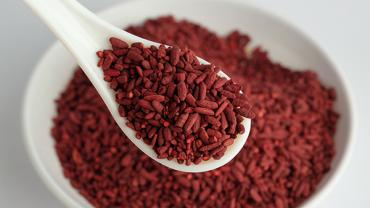
Red yeast rice (RYR) is neither yeast nor rice, but rather a product of the fermentation of white rice and the yeast, Monascus purpureus. It is also a nutraceutical rival to popular statin drugs. The efficacy of RYR as a cholesterol-lowering agent is a function of the constituent monacolin K, a chemical twin to the popular lovastatin. Like statin drugs, monacolins lower cholesterol by inhibiting HMG CoA reductase in the liver, thereby impacting the rate-limiting step in cholesterol synthesis.
However, unlike pharmaceuticals that can’t boast of additional health-promoting components, RYR also delivers polyketides, unsaturated fatty acids, phytosterols, pigments, and at least 13 different types of monacolins. Besides lowering cholesterol, it reduces blood pressure and has been shown to have anti-inflammatory, antidiabetic, anticancer, and osteogenic properties. Collectively, these additional benefits of RYR make it shine as a beneficial nutraceutical for cardiovascular health. A 2017 review gave evidence for RYR’s cardioprotective effects by stating, the “largest randomized controlled trial examining RYR in secondary cardiovascular prevention consisted of 4870 Chinese patients and showed that RYR reduces nonfatal myocardial infarction, coronary disease mortality, coronary revasculization, and total mortality in patients with a history of myocardial infarction and moderate hypercholesterolemia.”
RYR is among the most well-studied nutraceuticals, supported by a plethora of robust studies that have demonstrated its individual effects and compared it to traditional pharmaceutical agents for hyperlipidemia. For example, a 2016 systematic review compared RYR with simvastatin. It included ten randomized controlled trials involving 905 Chinese subjects with dyslipidemia. No statistically significant differences were observed between the lipid-lowering effects of RYR and simvastatin.
The cardioprotective effects of RYR may be a result of its effects on inflammatory factors as well as blood lipid levels. Although this outcome is not as well-studied in humans, a 2017 study on apolipoprotein E-deficient mice, randomly divided into a RYR, simvastatin, or control group showed that the RYR group showed decreased levels of high sensitivity C-reaction protein (hs-CRP), interleukin-6 (IL-6), and tumor necrosis factor-α (TNF-α) as well as reduced levels of matrix metalloproteinase-9 (MMP-9) and nuclear factor κB (NF-κB) in the aorta.
A previous study on apolipoprotein E-deficient mice also showed that RYR significantly reduced intercellular adhesion molecule 1, vascular cell adhesion molecule 1, matrix metalloproteinase (MMP) 2 and increased serum macrophage migration inhibitory factor. In the same study, RYR was shown to suppress angiotensin II-induced abdominal aortic aneurysm, a chronic vascular disease characterized by medial degradation and inflammation. With the administration of RYR, atherosclerotic lesion areas in both the intima of aortic arches and cross sections of aortic roots were reduced. Since both dyslipidemia and inflammation are compounding risk factors in cardiovascular diseases, RYR seems to be a dual agent for protecting the heart and blood vessels.
RYR is considered equally effective as pharmaceuticals for lowering cholesterol, and it also may present fewer side effects. In a 2017 single center randomized pilot trial, 60 dyslipidemic patients were evaluated for muscle fatigue after receiving either RYR or simvastatin. Patients in the RYR group did not experience fatigue or decreased physical activity compared to the simvastatin group. Nearly 10 to 15 percent of patients taking statin drugs experience skeletal muscle problems such as fatigue and pain, leading to a decrease in physical activity. Mitochondrial dysfunction is one purported mechanism for this side effect.
Additionally, statin drugs have been associated with other secondary effects such as higher liver enzymes (ALT and AST) and increased risk for type 2 diabetes, but a 2014 meta-analysis of five trials consisting of 352 patients showed that RYR does not significantly increase blood glucose compared to placebo. The renal and hepatic safety of RYR is comparable to traditional statin therapy with both showing only a 0 to 5 percent incidence of kidney or liver injury.
Overall, the safety of RYR is comparable or slightly better than that of statins. Poorly manufactured RYR can contain the mycotoxin citrinin, which is linked to several adverse effects, so good manufacturing procedures and quality control is critical.
Without doubt RYR carries strong evidence for its ability to reduce cholesterol and inflammation, and potentially reduce risk for compromised cardiovascular health.